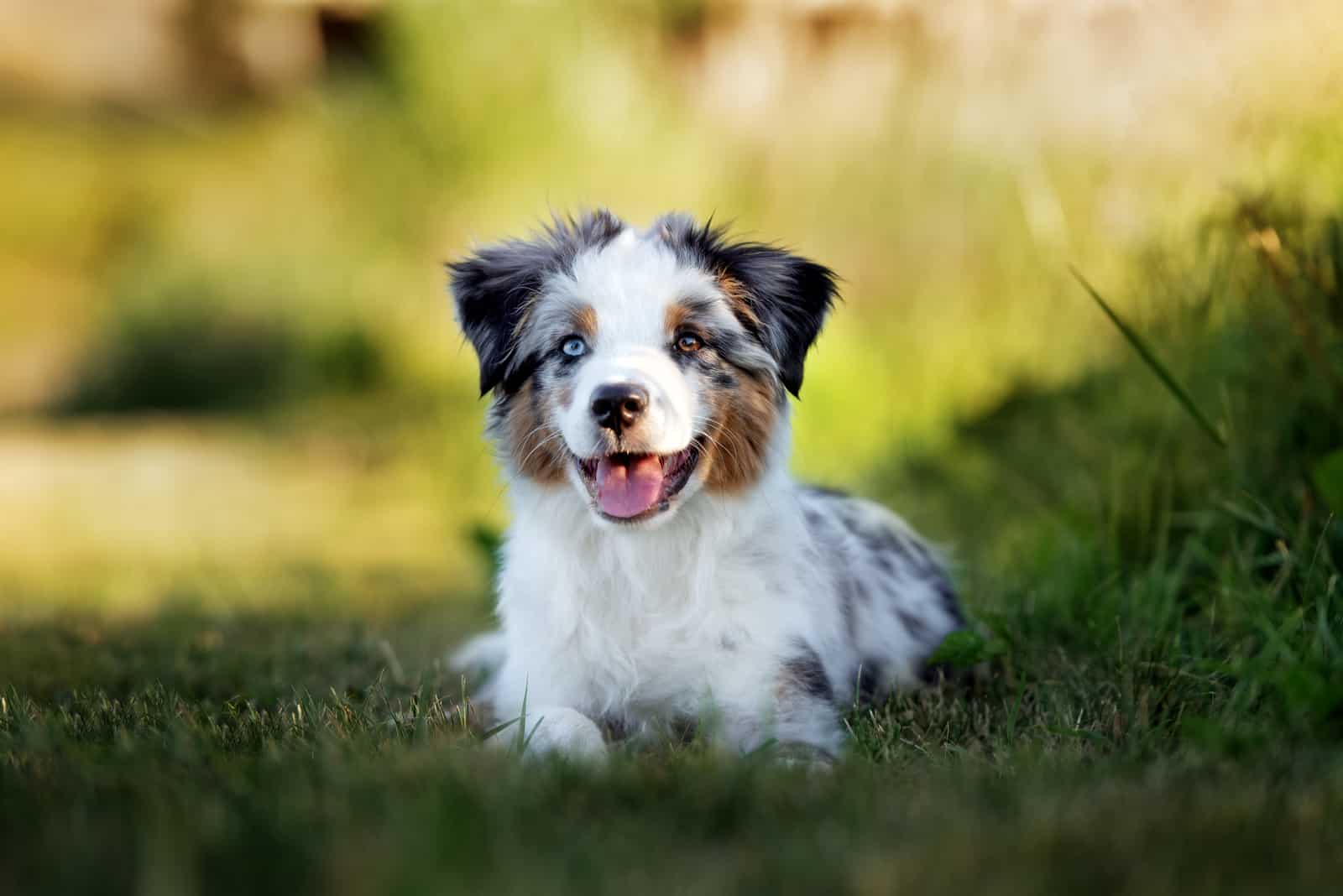Bringing a new puppy into your home is a fun adventure for the whole family. What surely awaits you are many happy moments, cuddling, and new activities with your furry friend. But what is also very important is establishing and maintaining a certain routine for your puppy.
Owning a dog is a lot of fun, but at the same time it is a huge responsibility. Every dog owner is responsible for feeding, training, socializing, and caring for their pet.
In order for you, your family members, and the dog to adapt to new life circumstances as soon as possible, it is very important to establish an adequate puppy schedule. What needs to be paid special attention to is establishing that routine as soon as possible.
While the puppy is still very young and getting used to life in a new home, this is also the period in which he will learn the most things.
This will not always go smoothly, and you will have to show a lot of patience and learn a lot of tricks to develop a loving relationship with your dog as soon as possible while also teaching him obedience.
To make this easier for you, we will provide you with instructions for establishing a perfect daily schedule that will work best for you and your pet.
What Puppy Schedule Exactly Means?
Every person’s life revolves around certain routines. Waking up, going to work, taking care of the home, socializing with loved ones… We all have certain fixed schedules that look pretty much the same most days. It’s the same with our dogs.
If you do a certain activity with your dog for two days in a row, on the third day the dog will be ready for that activity to happen again. In order for your puppy to grow up to be a happy and healthy dog, it is important that he gets used to a certain puppy schedule as soon as possible.
Every dog will feel a certain security when he knows what awaits him in his day. This applies to activities such as sleeping, feeding, playing, exercising, etc.
It may seem to you that your pet doesn’t need anything special to make their day. But in the eyes of a dog, it’s not so simple. When a dog has his own schedule, he will be less nervous and less stressed.
Maybe your new puppy is disobedient and scared, and you may be wondering when doggies get easier to handle. Well, maybe a regular dog schedule is exactly what your new pet is missing.
While this task may seem daunting and you might think that you will need the help of a professional dog trainer, perhaps you just haven’t tried the right approach yet. Therefore, it would be very useful for you to read our following instructions.
Feeding Schedule
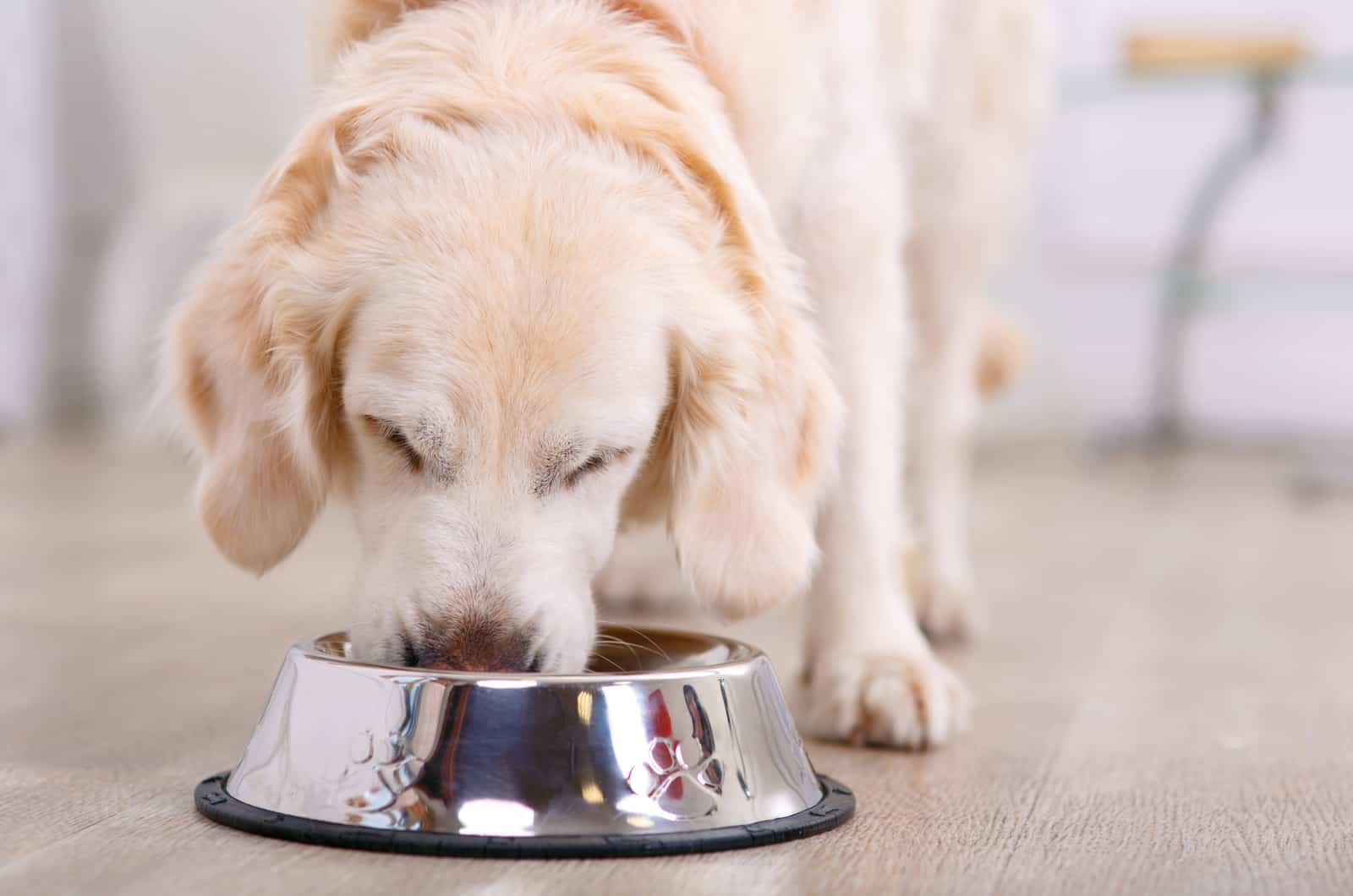
One of the most basic parts of the routine that your dog needs to get used to is the feeding routine.
The most important thing is to teach your new pup that he has a couple of mealtimes a day.
Do not leave food available to him for the entire day. In addition to the fact that too much food can lead to dog obesity, this behavior can make your dog become spoiled and think that he can eat whenever he wants and in the quantities he requires.
So, feeding time should be scheduled in the amount that is best suited to the dog in terms of its specific breed and age. You certainly won’t feed an 8-week-old pup the amount of food you would an 8-month-old one!
When he grows up, your dog will probably have two meals a day. But while he is still very small, he will need several meals a day. As a guide here, you can use your own meals – breakfast, lunch, dinner, and snacks.
When the puppy has finished eating, remove his bowl and clean it. Don’t forget to fill his bowl with water: dogs should always have access to water throughout the day. It is very important that your puppy gets used to having meals at the same time every day as soon as possible.
Importance Of Quality Nutrition
Establishing a perfect feeding schedule can be quite challenging when your puppy is still small and you are still trying to decide which food will be best for him: wet, dry, or maybe raw dog food.
Some dogs are quite picky, and you may need to try several types of dog food until you find one that works for your dog. Although this can be quite exhausting, be persistent.
Dog treats should definitely be a part of the diet, but they should not be the main part of it! Therefore, if your dog wants to eat treats, but refuses to eat dog food, it’s important that you discourage this.
Also, as much as we all like to share our meals with our dog sometimes, too much human food is never good for a dog. Only dog food has enough nutrition and vitamins that our dogs need to grow up healthy and happy.
Potty Schedule
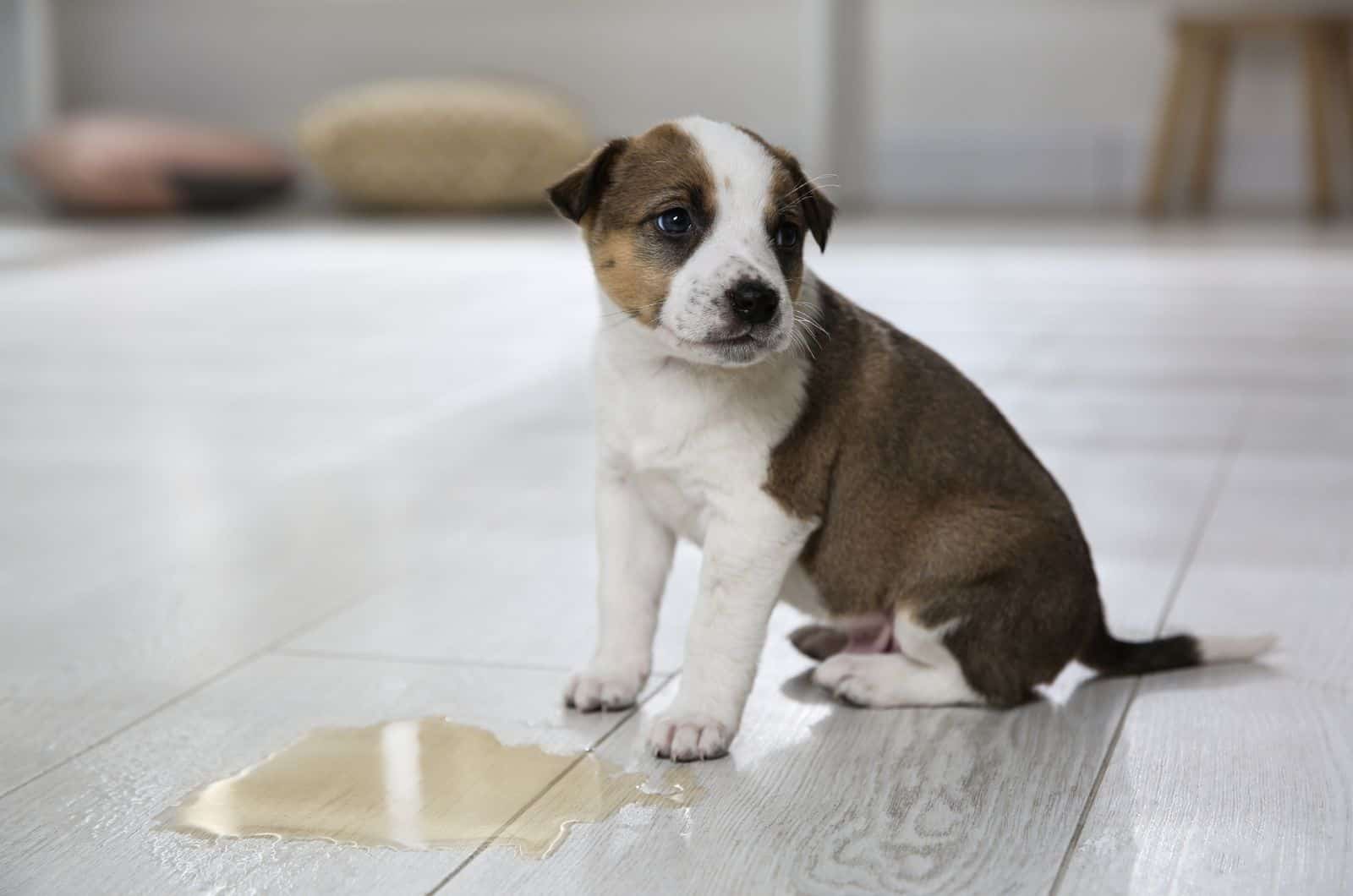
Even if you haven’t had a dog before, you’re probably aware that having a dog inside the home means that you’re bound to spend a lot of time at first explaining to your pet that the inside of your home is not a place for him to relieve himself.
So that you don’t have to ask for advice on how to clean diarrhea from the carpet, it’s important to get your pooch’s pooping schedule in order as soon as possible.
House training, or potty training, includes teaching a dog not to defecate inside the house but also teaching him that he will have a couple of potty breaks during the day.
The ideal time to start establishing a potty schedule is when the dog is between 12 and 16 weeks old. Some dogs will learn faster and some slower, but it is important to start training on time.
Keep in mind that young puppies need more potty breaks, as they still cannot control their bladders.
How To Create An Ideal Potty Schedule?
As soon as you get up in the morning, the first thing you should do is take your dog out for a potty break. Try to take the dog to the same place every morning and keep it on a leash. It is very useful to praise your pet after he has defecated.
Dogs respond very well to the method of positive reinforcement in training. As well as in the morning, puppies will also need to go potty after every meal, after a play session, and after nap time.
Also, make sure you take your dog out for a potty break every night, right before his usual bedtime. If you intend to leave the house, even for a short period of time, you should never forget to take your puppy out for a potty break.
In some cases, the dog will let you know on his own that it is potty time! You may notice that he is fussy, that he barks nervously, or that he scratches the floor.
You have to be aware that dogs will not be potty trained in a minute – perhaps, even if you are currently in the middle of this dog training, you will still have to deal with the issue of your dog pooping inside the house.
Just be patient and don’t punish your dog. Puppy potty training is not an easy or quick process, but your puppy will learn everything eventually.
Once he has been potty trained successfully, you will be able to leave your house for a couple of hours, without worrying whether your puppy will make a mess while you are away.
Sleeping Schedule
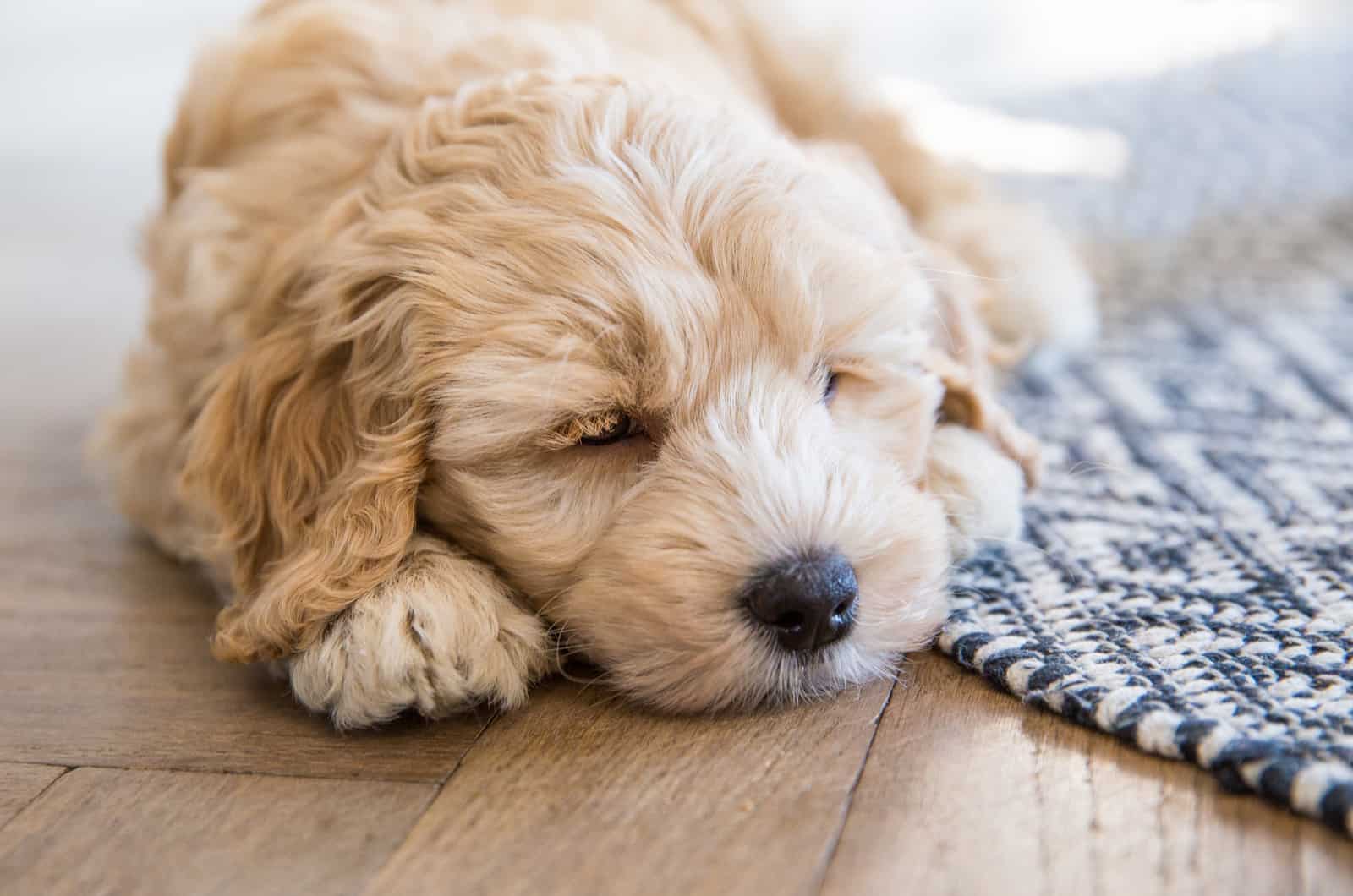
All dogs need plenty of sleep. An adult dog usually sleeps from eight to 12 hours. Young puppies should even sleep from 18 to 20 hours a day!
However, not all dogs can sleep this much for various reasons. If you notice that your dog is nervous or stressed, he may be lacking sleep. Therefore, establishing a sleeping schedule is another, very important, part of the dog’s routine that should be implemented as early as possible.
1. Give Your Puppy Alone Time
Your new puppy is like an interesting toy, especially if there are small children in your home. He is simply irresistible, and you are sure that he has enough energy to cuddle and play with each of you!
However, as we have already mentioned, puppies need a lot of sleep. In order for a puppy to sleep, it needs peace and quiet. This means that all family members should leave him alone to rest.
This may sound strange to you and especially if you don’t really understand why dogs would want to be alone.
Just like humans, dogs need rest to gather energy for all the fun activities that await them. It’s a good idea not to disturb your puppy when he is isolating himself and trying to sleep. The sooner your dog gets into his sleeping routine, the easier it will be for both you and him.
2. Coordinate Your Puppy’s Sleep With Other Routines
It is very important that you coordinate your puppy’s sleeping time with his other routines, such as feeding and potty breaks. After the puppy has eaten a meal and defecated, it’s time for his nap again.
Some dogs will nap for half an hour, and some for up to two hours. When they wake up, it’s time for other activities, like feeding again, potty breaks, and playing or walking.
After every activity, it is important that the dog rests again. You might be surprised by how much your puppy sleeps. However, lot’s of sleep is something every puppy needs. His mood, activity level, and obedience, will depend significantly on whether he has had enough sleep.
3. Crate Training
Crate training is a very important part of creating a perfect daily routine for your new furry friend. The ideal time to start crate training is when your puppy is between eight and ten weeks old.
Of course, when they are this small, we can’t expect our dogs to spend the whole night in a crate. To begin with, you can try leaving the puppy in the crate for about 30 to 40 minutes. It would be good if the crate was as comfortable as possible for your puppy.
If he has only recently arrived from the kennel, he might not be ready for instant interaction with you. If your dog seems sad or scared, creating a daily routine will be even more challenging.
In such cases, it is a good idea to put a blanket or a toy in the puppy crate, which you will have likely received in your puppy package. Most breeders send something like this so that the puppies can smell their mother and feel comforted while they are getting used to their new home.
As a puppy gets older, the amount of time he spends inside his crate should be extended. For example, a three-month-old puppy should spend from one to three hours in his crate, while a 4-month-old puppy is ready to spend around 4 hours inside his crate.
The crate might be scary for a puppy at the beginning of this puppy training, but, with time, this will become his safe and comfortable space where he loves to sleep and spend time alone.
So, crate training is an important tool for establishing a sleeping routine for your puppy.
Exercise Schedule
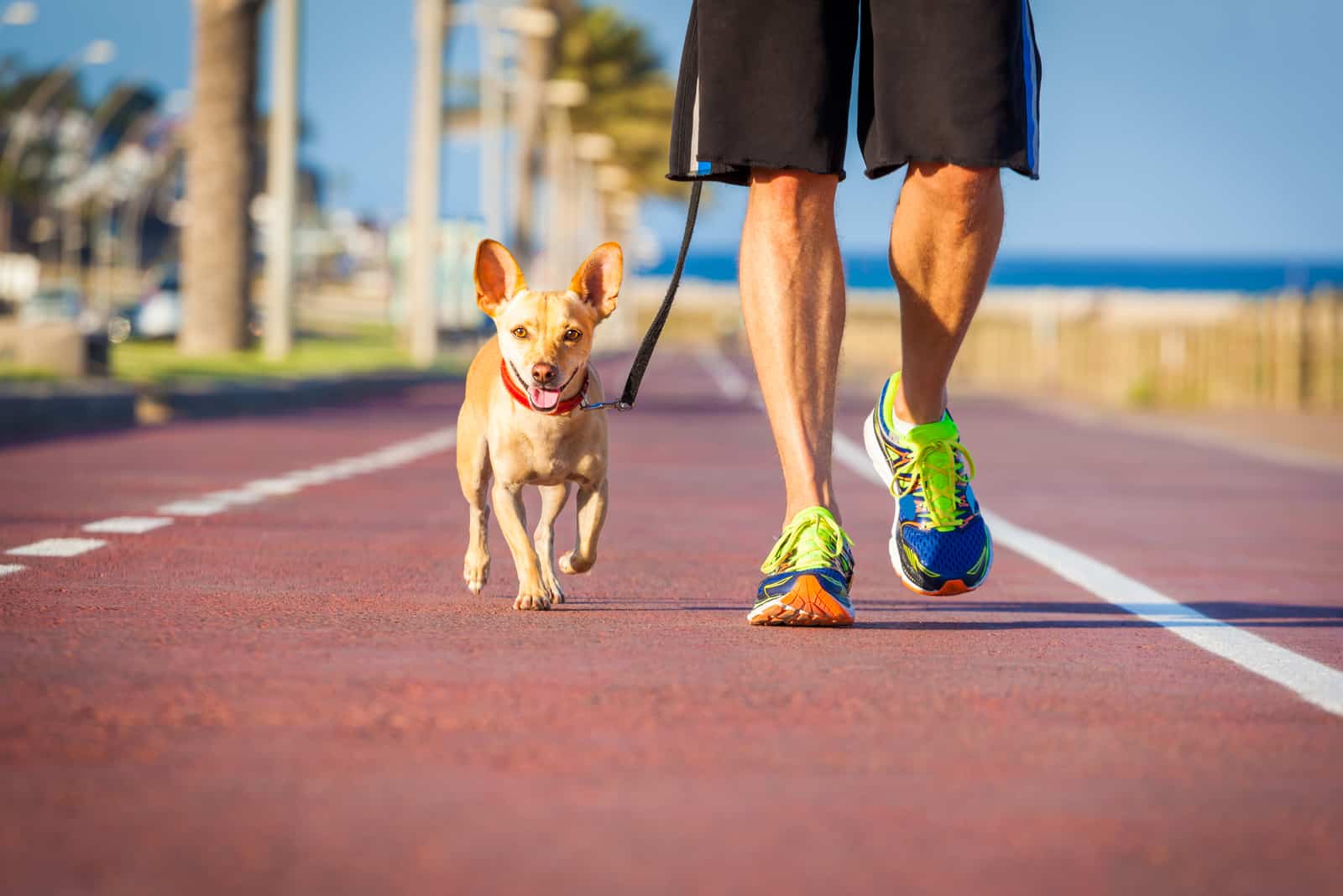
Exercise is a very important part of a dog’s daily routine. The amount of exercise will depend on the dog’s breed, its age, weight, health, and alertness. Even when he is still very small, a puppy needs certain physical and mental activity.
However, it is important to make sure that, while the puppy is still very young, he does not overdo it with exercise. First, make sure your dog does not have a medical condition such as hip dysplasia or elbow dysplasia.
Activities such as intense running are not recommended for dogs under 12 months of age. Before this age, the dog’s cartilage and bones are not fully fused and could be damaged if the dog starts exercising intensively.
Also, a young puppy should not jump from great heights. Excessive exercise can harm a developing puppy, but, on the other hand, light walks and play sessions are highly beneficial. These activities help your puppy’s bones, cartilage, ligaments, and muscles to develop.
1. Walk Time
You can start taking your puppy for walks after he has received his first vaccinations. This usually happens when the puppy is around eight to ten weeks old.
Before you take your puppy out for a walk for the first time, it would be a good idea to familiarize him with the dog collar.
You can put it on him several times before a walk, while you are at home. Let him wear it for a while so he gets used to it and doesn’t freak out when you put it on him when it’s time to go for a walk. Don’t forget to use a leash when you go for a walk. Every dog should be walked on a leash.
How often you walk your puppy is very important for his overall health. The general rule is that for every month of the puppy’s age, there is a five-minute walk. So, a three-month-old puppy should have 15 minutes of walking, two times a day.
Benefits Of Walking Your Dog
Walking with a dog brings various benefits. One of the main benefits is that you form a stronger bond with your furry friend. A walk is also an opportunity for your dog to defecate. When walking becomes part of a puppy schedule, it also becomes a form of puppy socialization.
During the walk, you and your dog will meet other dogs and their owners. This means that the dog will get used to the presence of other dogs from an early age and will learn what behavior is desirable and what behavior is absolutely not allowed.
After a few walks, you will be able to judge for yourself how your dog reacts, whether the amount of walking suits him, if he needs additional exercise, or if he looks exhausted.
If you are not sure whether you should change something, you can always consult your veterinarian.
2. Playtime
Your puppy will probably show the desire to play when he is still very young. Playing is a great way for a dog to use up its energy and spend time with its human family.
Children are the family members who will probably want to play with the puppy the most. It is important that any play session between puppies and children is always supervised, so that neither the dog nor the children are injured.
When your puppy is around eight or nine weeks old, it would be good for him to have a play session two to three times a day. This may involve playing with dog toys or playing with family members.
Playing can last 15-20 minutes or more, depending on how involved the dog is. When you notice that the dog has become bored or tired, it is time to stop this training session and let the puppy rest for a while.
When your dog came to live in your home, he was most likely eight weeks old or more.
During the period when he was still living with his mother and his siblings from the same litter, it is likely that he was also involved in some form of play with them, such as wrestling on the floor or biting each other.
This is harmless while the puppy is still very young, but it is important to show him the correct ways of playing so that this kind of behavior does not develop into aggression in dogs.
When the puppy is around three months old, it’s time to start playing fetch. As the puppy grows up, you need to increase the playing time and change the toys so that your pet doesn’t get bored.
Playing is a very important form of both physical and mental exercise for puppies. Through this activity, your dog will be physically active, adopt good behavior rules, and tire himself out, which will lead to a proper feeding and sleeping schedule.
3. Mental Stimulation
Mental stimulation is even more important for young puppies than physical exercise. In order for a dog to use its congenital skills, it is very important that its environment is rich in mental challenges.
In order to achieve this, you don’t need to buy some expensive toys that will help you mentally stimulate your puppy. You can use various things that you already have at home! For example, you can hide your dog’s favorite toy and watch him while he tries to find it.
In this activity, the dog will use sniffing and digging to get to the desired toy. Watch him the whole time and make sure he doesn’t get nervous or frustrated. If he needs help in the beginning, be sure to provide him with it.
And don’t forget to praise your dog for a successfully completed task!
Furthermore, a simple move such as a new walking routine is also a type of mental stimulation for our puppies. This is because they will have a chance to sniff around a place they have not visited before and will encounter some new things in their environment.
Training Schedule
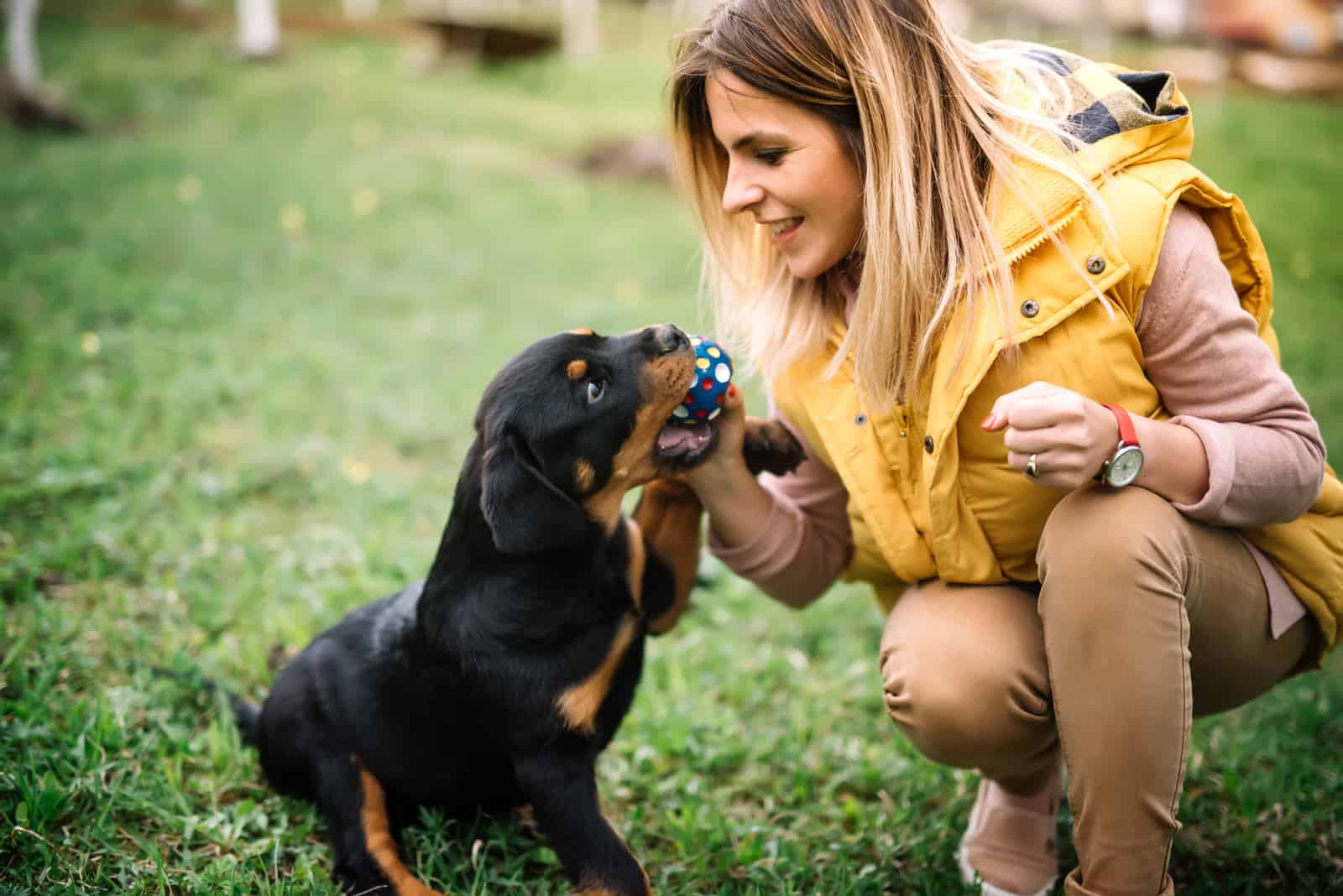
A dog does not become well-behaved just like that. In order to achieve this, it is necessary to establish a dog’s training schedule as early as possible.
At the very beginning of your life together, the dog may seem frightened, uninterested, or may even show signs of undesirable behavior.
To change this and to get a dog that is obedient and tame, we have put together some training tips to help you establish an appropriate puppy training schedule.
1. Basic Commands
You can start teaching your puppy first commands when he is around eight to ten weeks old. Puppy owners mostly start with basic commands such as sit and come. This is also the period when your puppy should learn his name.
The ideal time to teach your puppy these basic commands is feeding time. Chances are your puppy will learn the come command very quickly when he knows his favorite meal is waiting for him!
When they are around 12 weeks of age, puppies are able to learn additional commands, such as down and place. When your puppy is around 4 months of age, you can start teaching him commands such as leave it and stay.
After your puppy is about six months old, you can mentally stimulate him by adding various commands and checking how easily he learns them.
If you have been teaching him the commands in your home or in an area that is well-known to your puppy, it is time to change the location. Take him to nature or to an unknown park and test how your dog reacts to learning new commands.
The speed of learning to master basic commands depends a lot on the dog breed. Dogs that are considered the smartest breeds will learn faster, but it is not a reason to give up if it seems to you that your puppy is learning significantly slower.
Be persistent and patient, give your dog time, and don’t force him. If you notice that he has not mastered one command well, do not move on to another. Each dog has its own learning timeline.
2. Socialization
The process of socializing a puppy begins from the moment it enters your home. In the first few weeks, socialization will be about building a relationship between your family and the puppy. During this time, the puppy should also meet some of your closest friends and relatives.
When the puppy is about 12 weeks old, socialization involves exposing the puppy to new sounds that it will often encounter in the outside world. After your puppy has been vaccinated, it’s time for him to meet other dogs.
Here, it would be good to first expose him to a dog that you already know, so that he does not have a traumatic experience, and so that the first meeting with another dog does not result in aggressive behavior. Aggression in dogs is often caused by fear of the unknown.
If you see that socialization training is not working for your puppy and he is showing signs of aggression, our article on How to socialize an aggressive dog might be helpful.
When the puppy is older than six months, you can slowly start extending your walks and taking it to unknown places. If everything so far has gone according to plan, the puppy should already behave well in the company of other people and other dogs.
3. Dealing With Puppy’s Chewing
Dogs love to chew on things, and these things often include our shoes or clothes! The teething period for puppies is from around 12 weeks old, and this is the main reason for their chewing behavior.
It can be quite painful for them, and they will look for a way to relieve themselves. Some will chew on things, and some will even try to bite their owners out of nervousness! Well, if you’ve been wondering ‘Why won’t my dog stop biting me?’, maybe this is your answer.
Not all chewing can be described as destructive chewing in dogs, but this behavior can be quite challenging for puppy owners.
In order to prevent your dog from chewing on your things, it is a good idea to introduce him to chew toys from the moment you notice a pronounced need to chew things in your puppy.
This usually happens when the puppy is about 12 weeks old. In addition to being good for relieving dog teething pain, training your puppy to use chewing toys is also useful for strengthening the dog’s jaw.
4. Puppy’s Alone Time
Training a puppy to stay home alone is probably one of the most difficult parts of dog training. However, although this can be quite demanding, the sooner you introduce this into your puppy’s schedule, the easier it will be for both you and your pooch.
When your puppy is about ten weeks old, you can start leaving him alone at home for short periods of time. Here we emphasize the importance of the shortness of the period of time that the puppy will be alone.
A puppy this young should not be left home alone for more than 15 or 20 minutes. In addition to the fact that he needs frequent potty breaks, the dog can also become anxious if he notices that you are not there.
Before you leave your puppy home alone for the first time, you can leave the radio or TV on. It is also good to leave him a piece of clothing with your scent so that he feels comforted.
As the dog grows up, you can gradually increase the amount of time it spends alone. A three-month-old puppy should not be alone for more than three hours, and a six-month-old puppy should be able to spend about four hours alone.
Grooming Schedule
Grooming is also a very important part of caring for a dog. The sooner you introduce a grooming schedule for your puppy, the better it will be for his health, but also for your bonding.
Regular brushing will reduce your puppy’s shedding and keep his fur healthy and shiny. Bathing your puppy is also important – regular bathing will not only keep your puppy clean and smelling nice, but you will also be able to assess whether there are any changes in its skin or fur.
In addition to bathing and brushing, it is important to take care of your dog in a few other ways , such as regular ear cleaning and regular brushing of the dog’s teeth.
Furthermore, nail trimming is an indispensable part of taking care of our puppies. If you need help with this procedure, you can find useful tips in our article on the subject: How to sedate a dog for nail clipping.
All these parts of dog care should be started as soon as the puppy comes into your home. Of course, you should first make sure that the puppy feels at ease in your home and that he trusts you.
A dog that is startled or nervous will probably not let you touch, brush, or bathe it. Therefore, grooming should come after you and your new puppy have formed a certain relationship.
What Is A Good Daily Routine For A Puppy?
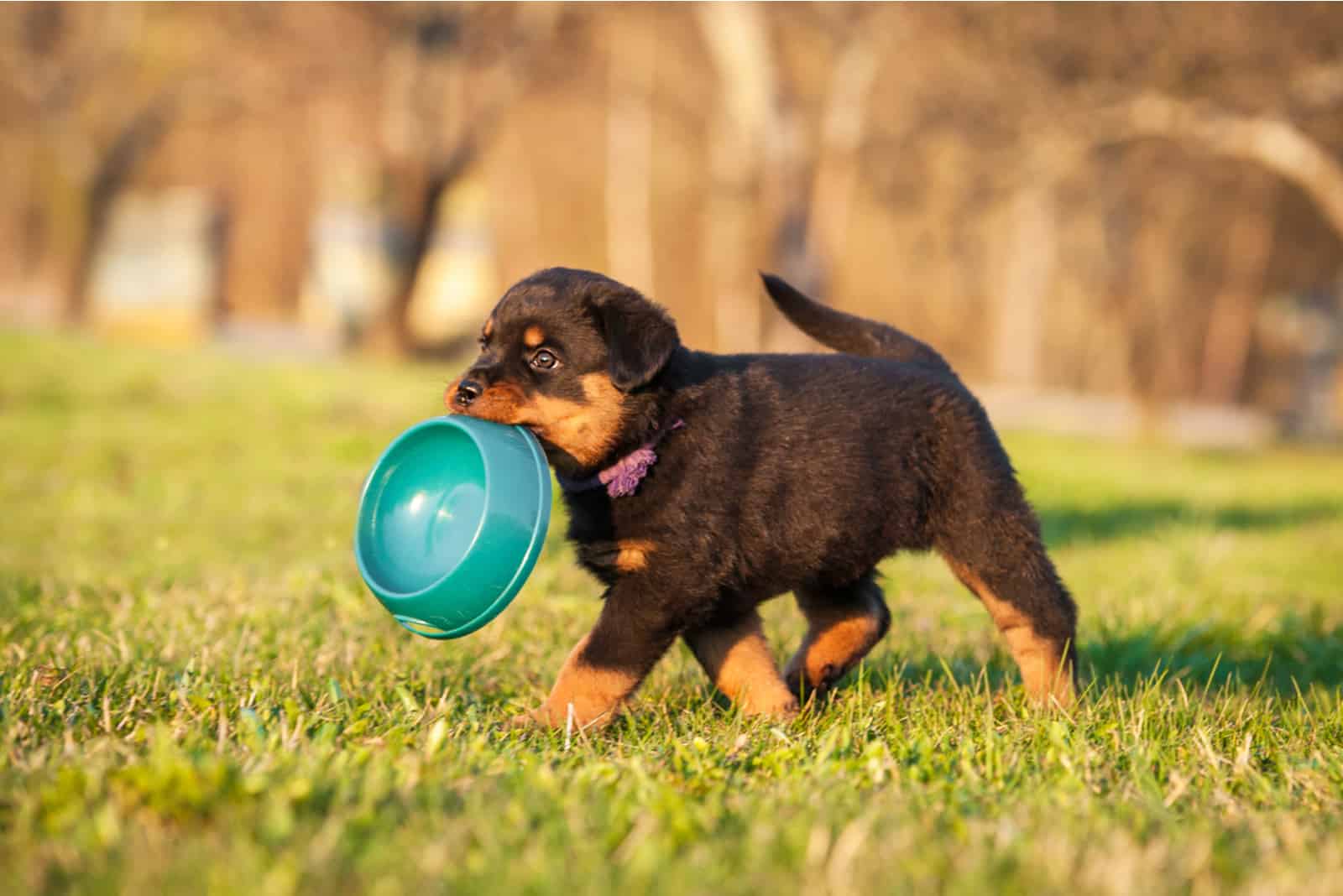
Now we know roughly what should be included in our puppy’s daily routine. At a first glance, it may seem like a lot goes into this routine, and that our pooches might be overwhelmed by this schedule.
But over time, you will see that this is actually quite simple and very necessary for your puppy to function normally.
Below is an example of what a good daily routine for a puppy should look like. Of course, this does not mean that you must strictly follow this routine. Every dog owner should coordinate their own obligations and daily schedule with the needs of their pet.
It is true that puppies really require a lot of attention, especially when they are this small and quite helpless. But just one look at that adorable face and those tiny paws and we’re already sure that it’s all worth it!
What A Puppy’s Daily Schedule Should Look Like?
1. Day Should Start With A Potty Break: The first thing you should do every morning is take your puppy out for a potty break. Every dog is ready to defecate as soon as it gets up in the morning. Puppies who are still not potty trained and who are very young may also need potty breaks during the night.
2. First Meal: After the puppy had his first meal, it is time to take him out for another potty break.
3. It’s Playtime! After the meal, the puppy should play for a little bit – either with you or with his favorite toys.
4. Naptime: The puppy has eaten and used some of his energy while playing, so it is time for him to have a short naptime. Don’t forget the potty break after naptime!
5. Training Time: After the puppy has rested a little, you can use this time to train with him for a short time, for example, teach him a command.
6. Second Meal: It’s time for the second meal of the day, which should be accompanied, of course, by an additional potty break.
7. Walk Time: After the second meal, it’s time for some more exercise. This time it can be a short walk around the neighborhood.
8. Naptime Again: The puppy has just returned from his walk, so it’s time for him to take a break and gather energy for the rest of the day.
9. Third Meal: Now it’s time for the puppy’s last meal of the day, and another potty break.
10. Grooming Time: Before the puppy is ready to sleep, you can use this time for brushing, ear cleaning, and similar puppy grooming activities.
11. Time To Sleep: It is time to say good night to your puppy! Don’t let him go to sleep before he has gone for the last potty break.
Consider Your Puppy’s Needs
The previously described routine is a general outline of the daily schedule for puppies. This, of course, does not mean that every puppy will need the same things at the same time of the day. Some dogs will require more exercise, and some will enjoy longer naps.
Some puppies will need more meals a day. Some will learn to control their bladder sooner, while some of them will need more potty breaks in the day than we have indicated.
So, the key to a perfect daily routine is to recognize your puppy’s needs. When you see that an activity does not suit him or that he seems exhausted, or nervous because he is bored, it is time to change something in his routine.
With time and a little effort, you will find the schedule that will be ideal for your dog to be happy and satisfied.
To Sum Up
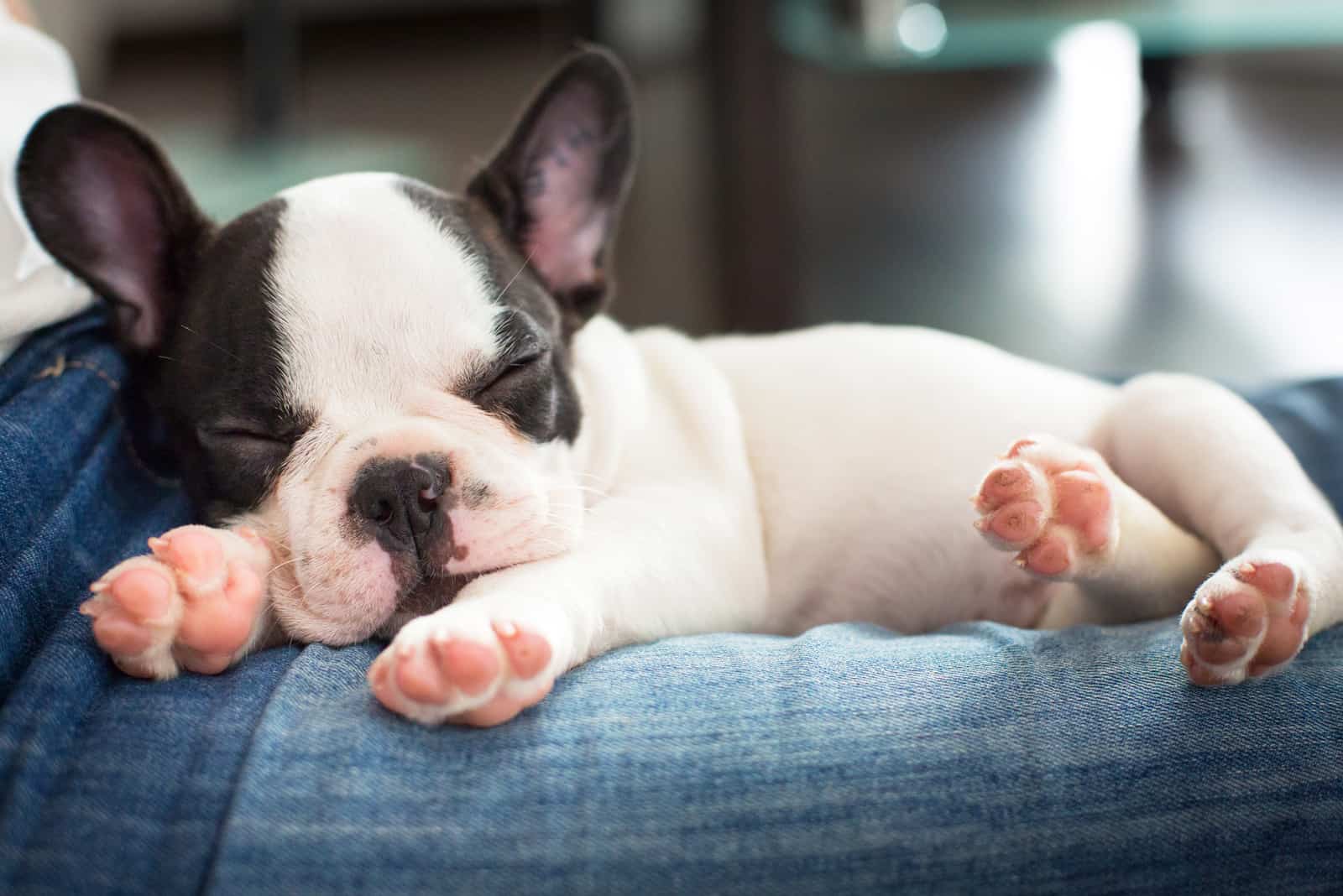
The beginning of life with a new puppy is a special, exciting adventure for all owners. In order for the habituation period to go as smoothly as possible, establishing a puppy schedule is crucial.
The truth is that there are many aspects you will need to consider and become familiar with, in order to successfully create a daily routine for your puppy.
We hope you find this step-by-step guide to all the parts of a dog’s schedule useful. At first, it may seem quite extensive and complicated, but trust us, after a while, both you and your dog will get used to it. And then follows the fun coexistence with your furry friend!
All aspects of a dog’s schedule are equally important – feeding, sleeping, training, exercise, and grooming. It’s just up to you to find the ideal routine that will fit both your schedule and your free time.
Thanks to following this schedule, your puppy will grow into a well-behaved and well-trained adult dog.
A regular daily routine will make your puppy feel more secure in his environment and he will always know what awaits him next. We wish you lots of luck and fun in establishing and implementing a suitable schedule for your beloved pet!
